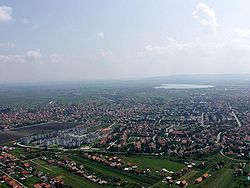Veliko Blato
| Veliko Blato Велико Блато |
|
|---|---|

Aerial view of Borča with Veliko Blato in the distance
|
|
| Coordinates | 44°51′46″N 20°29′41″E / 44.862759°N 20.494819°E |
| Primary inflows | none |
| Primary outflows | none |
| Basin countries | Serbia |
| Surface area | 1.8 km2 (0.69 sq mi) |
| Max. depth | 1.5 m (4.9 ft) |
| Settlements | Belgrade |
Veliko Blato (Serbian: Велико Блато) is a lake in Krnjača, an urban neighborhood of Belgrade, Serbia. It is located in the municipality of Palilula.
The lake is located in the northern section of Krnjača, 10 km (6.2 mi) north of downtown Belgrade. It is positioned at the tripoint of the neighborhoods of Borča, Ovča and Krnjača.
Veliko Blato is situated in the southern part of the Pančevački Rit marshland. The lake is generally heart-shaped and covers an area of 1.8 km2 (0.69 sq mi) or 2 km2 (0.77 sq mi) with the adjoining fish ponds. It is the largest body of water in the Pančevački Rit, though it is shallow, as the maximum depth is only 1.5 m (4 ft 11 in). The area of the entire protected zone which surrounds the lake, and includes four fish ponds to the north, is 3 km2 (1.2 sq mi). The lake is embedded in the depression between the reed covered wet floodplains. The lake has no inflows or outflows, though the entire northern part is encircled by the Sebeš canal and another canal closely engulfs the entire lake. Water is replenished from the Danube and through the underground springs.
The name of the lake means "great mudflat" in Serbian.
In and around the lake there are 191 plant species, out of which 14 are protected. Since 1865, when Josif Pančić found the first specimen, 30 species of orchids have been registered on the territory of the City of Belgrade. Two of them can be found only in Veliko Blato. One is marsh helleborine (Epipactis palustris (L.) Cr.), with some 200 individual plants. It grows only up to 20 m (66 ft) from the canal which encircles the lake. It was discovered near the lake in 2012. The other, with only some 50 specimens, is Orchis palustris Jacq. It grows between the turfs of grass where the water has dug minute canals. It was spotted for the first time in Belgrade in 1896 on the Great War Island, but was never seen again there. It has been re-discovered in the Makiš area in 1955, but by 2001 it disappeared, too.
...
Wikipedia
